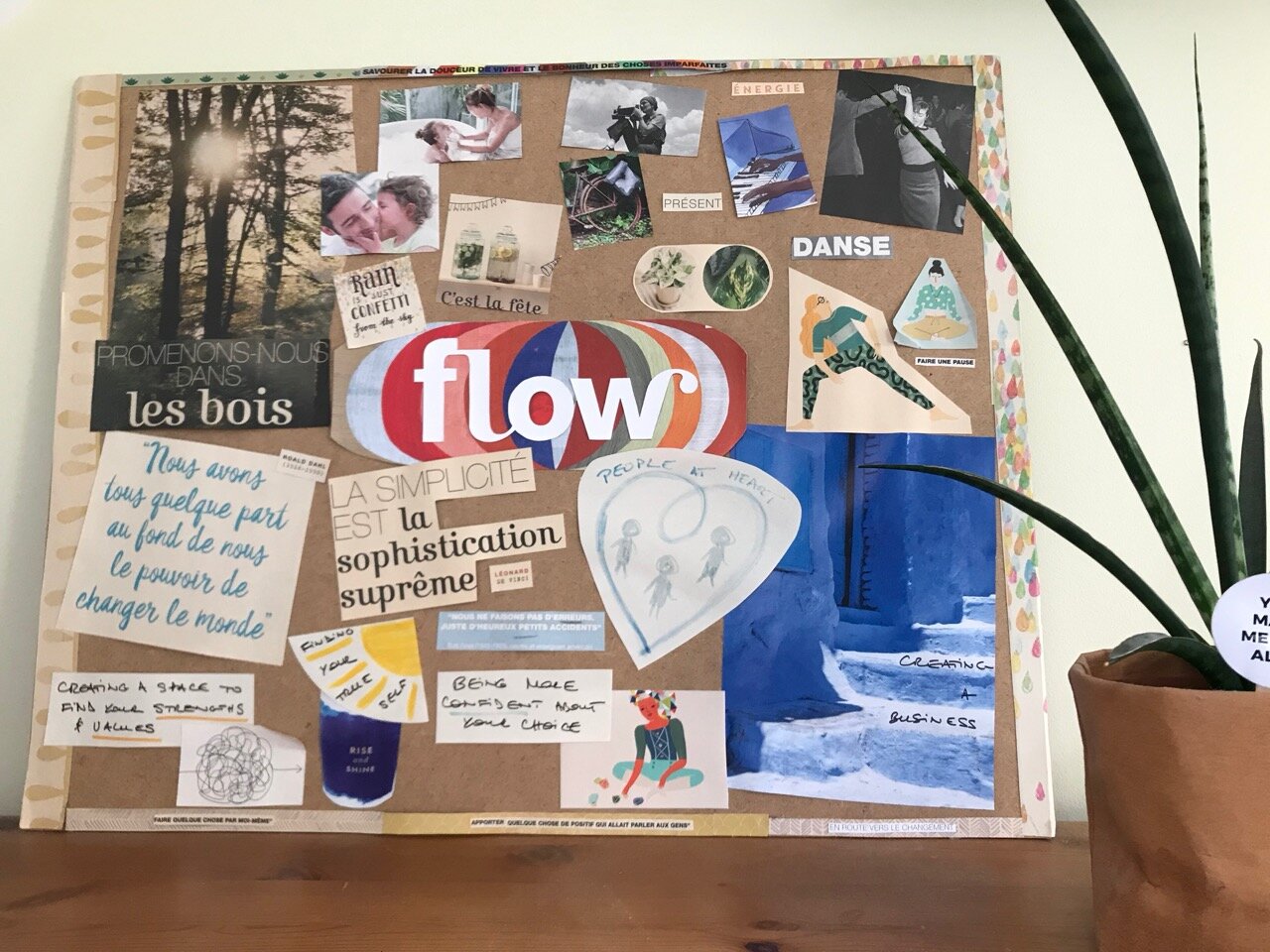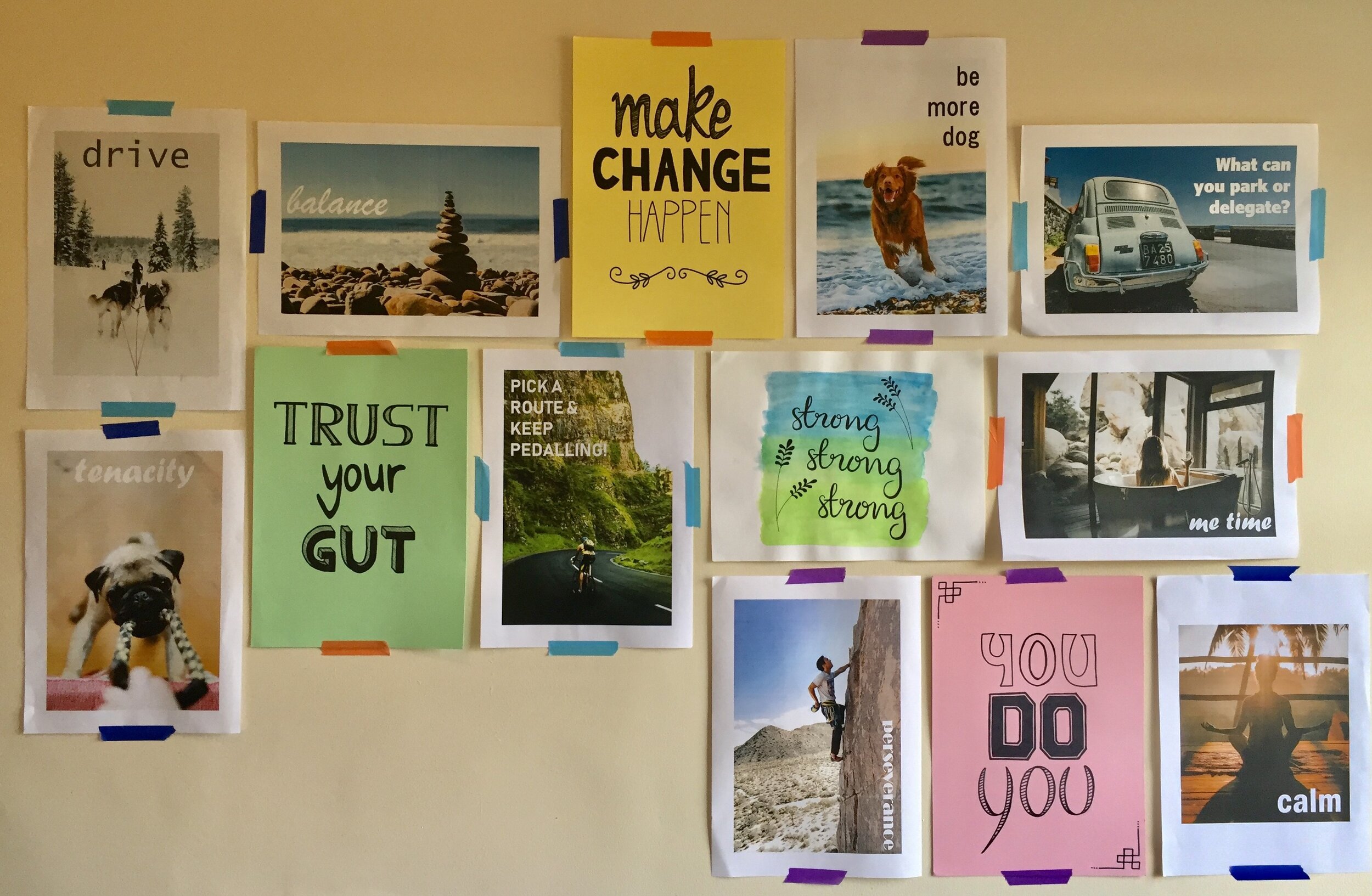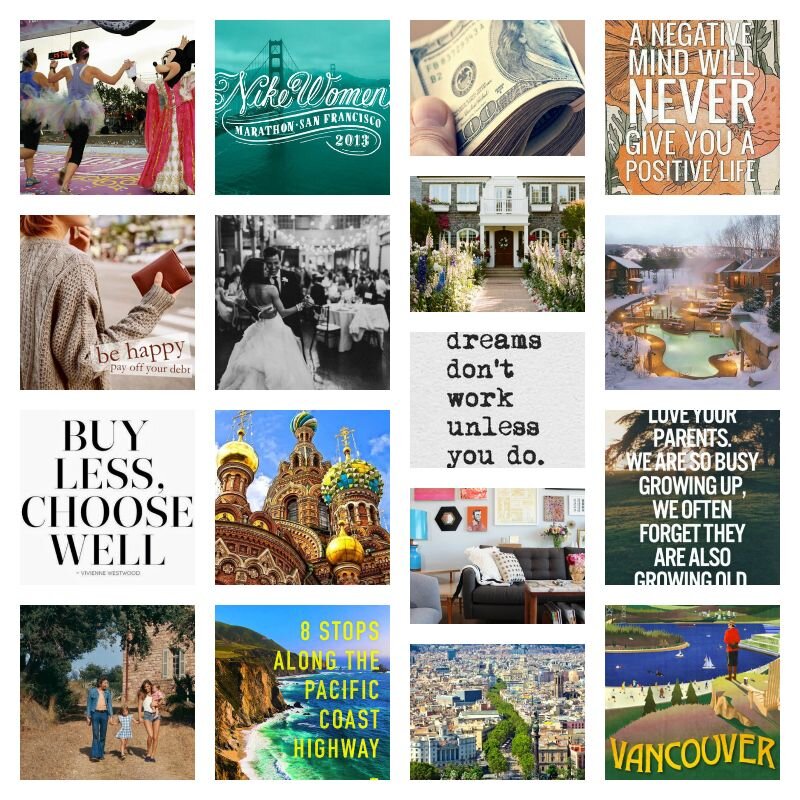Create a vision board in 4 steps
Creating a vision board is a way to remind yourself of what you are aspiring to achieve. Here's a guide and a worksheet to help you get started.
Set time aside
Creating your vision board can take you 2 hours or 2 days. It depends on how much time you want to spend on it! You could also do it in a few different sessions if you want to take time to reflect in between.
I’d recommend setting at least 2 hours aside to start filling in the worksheet, going through magazines or the internet to find the pictures that you want to use and pasting it on a board. That’s the time I take to run my Vision Board workshops so it’s a good starting point. But it might not be enough, so don’t get frustrated and book yourself another working session to continue working on it!
Why do you need a vision board?
Technically you can live without one. But they’re very useful to create a visual reminder of the direction that you want to follow.
There’s a bit of neuroscience behind visualisation and vision boards that explains why they’re so useful. Here’s an article by a proper scientist that explains you how it works. But the core message is that it will train your brain to recognise the opportunities that are aligned to your goals.
When do you need a Vision Board?
That’s up to you!
There’s a lot of ‘vision board marketing’ happening around December/January as it can be a great way to start the year by setting your goals.
But you can do your vision board AT ANY TIME of the year, and that’s because the focus of your vision board can be more than just the next 12 months. It could be your 10-year vision, your home vision, your relationship vision. A vision board can last a few years (that was the case for my first vision board!), so you can create it whenever feels right.
Ready to dive in?
HEre are the steps to make your vision board
1. Decide the focus of your vision board
You can do a board on whatever you want but it’s good to start with a point of focus. Your board can cover different aspects of life, such as health, home, career, family, relationships, holidays, hobbies, etc…
You could focus on:
A specific goal(s)
What you want to achieve in the next 12 months
The ideal lifestyle you want to have as part of a long-term vision
Your business
Write down what you want your board to focus on, and start jotting down the words or phrases that are coming to your mind. Think about what you want to achieve, but also how you want to feel. Bringing your emotions on the board will make it even more powerful.
Here are some questions to help you start:
What do you want to do more of?
Who do you want to spend time with?
What do you want to discover and learn about?
What do you want to achieve?
If you’d like to spend more time on that step, you could write your vision of the future or complete my ‘reflect & plan’ process. By taking the time to really think about what you want, your vision board will be even more complete.
Decide NOW if you’re going to create a physical or digital board
A physical board will need to find a space in your home, so that you can see it often, whereas a digital board can be on your laptop or in your phone to look at frequently. It really depends on your preferred style.
You can create digital boards on Canva for free: they have an amazing library of templates and pictures and you can add your own pictures too. You could also create a collage in PowerPoint or use Trello.
If you’re making a physical vision board, figure out what you’ll use as a board. You could use a picture frame, a corkboard or fill up empty wall space.
2. Find the pictures and words that inspire you
If you have decided that you'll do a physical picture board, pick magazines that resonate with you and that have a mix of picture and text. I personally select wellbeing, mindfulness, decoration and travel magazines, but if you're not sure what to choose, go to your nearest newsagent and browse different titles to see what attracts your eye.
If you want to do a digital board, you can search for pictures on Pinterest and Google Images. Also, check out royalty-free picture websites such as Unsplash and Pexels, as well as icons collections on Noun Project. You'll need to have a list of keywords to start with: you can use what you’ve done in Step 1 to create that list.
Choose pictures and words that represent your goals and speak to your heart in some meaningful way. Look for those that immediately make you say, “Yes! That is what I want in my life!”.
They don’t have to be physical objects or literal interpretations of what you want in your life. Instead, focus on how the images and words make you feel. For example, if you’d like to move to a house by the seaside, don’t hunt for the picture of your perfect dream home. Maybe a picture of a beautiful sea view will be enough to inspire you. Or if you’d like to attract new relationships into your life, instead of hunting for a picture of a man or woman who meets your physical ideal, find a picture that represents love to you – an image of two people holding hands, or the picture of a heart.
You can also add things that you want to look at every day and will inspire you: photos of family and friends, quotes and sayings that you like, reminders of events, places or people, postcards from friends, etc.
Words are as important as pictures. Maybe the words you chose will describe how you want to feel, or maybe it's a quote or a sentence that resonates with you.
And finally, if you can't find the words or images that you want in the magazines, why not try to draw them yourself?
3. Make a collage
Once you have collected enough photos and words, it's time to put your board together.
Paste, glue, tack, pin or tape your pictures and words in an arrangement that is visually pleasing to you. You can also add stickers, washi tape and pattern paper to fill in the gaps.
This can take time and you might want to start doing it, take a break and go back to it later to finalise it.
4. Find the right place to display your board
To get the full benefit from your vision board, it's important to put it somewhere you can see it every day. It could be in your bedroom, your home office or your kitchen. If it's a digital board, it could be your desktop background or screensaver. Look at it often, to remind yourself of what you want to achieve and connect with the feelings that underpin your aspirations.
Final thoughts
Updating your vision board
You could decide to do a new one every year, or you can change elements of your board when it feels like you can move onto something new. For example, if you have achieved a specific goal that was on your board, you can remove the words or pictures associated with it, and replace them with a new goal.
Keeping track of your progress
Every so often, take a moment to look at your board and reflect on what you’ve done. You could journal your achievements, challenges, actions to come back to later. I’d recommend doing this at a frequency that works for you, but if you’re not sure you could start by doing it every 2 or 3 months.
Being resilient
Once you’ve set your vision and created your vision board, stuff won’t happen overnight. It’s going to take work, time and sometimes it might be slower than you hoped. Don’t forget to give yourself a break and to remind yourself that it’s ‘work in progress’.
Attending a workshop
You might also find that you’d rather attend a workshop where a facilitator brings all the materials and take you through their process to create your board. Search on Eventbrite or Google for Vision Board workshops near you. If you’re in London, I run a few workshops throughout the year so keep an eye on my Instagram to see when’s the next one!




